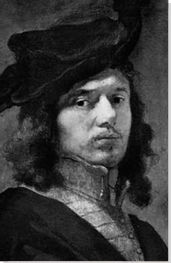Summary of Carel Fabritius
Though less well known than his Dutch Golden Age contemporaries due to his tragic and untimely death, Fabritius was a bone-fide free spirit working within the Baroque tradition. He left only a small number of portraits and genre paintings - just 13 confirmed artworks - but these reveal him to be an artist of no little historical significance. Indeed, he is considered Rembrandt's most gifted and important student and, having left the great Dutch Master's charge, he went on to become a key figure within the mid-17th century School of Delft; a group known predominantly for its views of the city and its daily life, coupled with quieter, more considered, interior compositions. At Delft, his work typically employed delicate shading with dark figures set against a light background. His interest in the laws (and limits) of perspective and pictorial spatial relations, meanwhile, saw him share an affinity with his fellow Delft artist, Johannes Vermeer.
Accomplishments
- The artist's two greatest masterpieces, The Goldfinch and The Sentry, each display an extraordinary clear light and atmospheric tone which mark an emphatic break with Rembrandt's heavy chiaroscuro model. Of all his surviving works, these two paintings celebrate the artist's willingness to investigate subtleties in compositional illusionism and narrational ambiguity respectively.
- The surviving paintings of Fabritius's show a highly refined technique. His early reputation was built on a series paintings through which he experimented with combinations of glazes and carefully chosen areas of impasto. Through the latter technique, passed down in history through the likes of Titian, Tintoretto and Rubens, he was able to create domestic narratives of tactile depth and texture.
- Fabritius ignored the stress on iconography that characterized the Renaissance style focusing rather on the formal aspects of painting. His interest lay in the technical aspects of color harmony, lighting and perspective and his treatment of weather effects in particular have been singled out for their delicacy.
- Fabritius's interest in pictorial space led him to experiment with a cylindrical perspective box (a device that was popular amongst Dutch artists during the seventeenth century). The perspective box enabled him to produce a convincing illusion of an interior or exterior space with the inside of the box painted in a way that, when viewed through a small opening or peep hole, gave a convincing illusion of a three-dimensional space.
The Life of Carel Fabritius
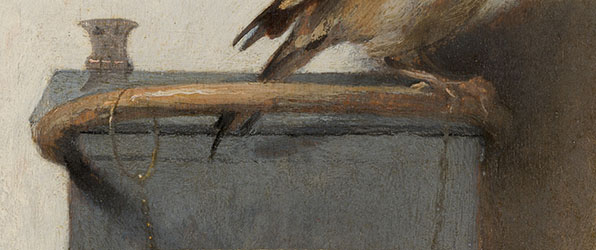
Carel Fabritius's best-known work is undoubtedly The Goldfinch, which he painted at the age of 32. That same year Fabritus perished in the "Delft Thunderclap"; when 40 tons of army gunpowder was accidentally ignited, killing an estimated 100 people.
Important Art by Carel Fabritius
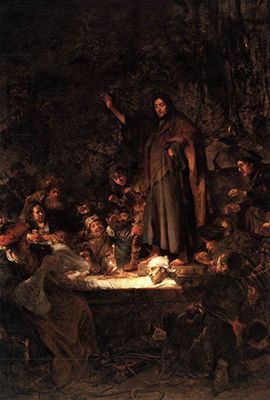
The Raising of Lazarus
Though he would soon produce artworks very much in his own style, Rembrandt's influence is pronounced in the Raising of Lazarus, one of Fabritius's earliest known canvases. Indeed, Fabritius renders this well-known scene from the Bible, in which Lazarus rises from the dead, in his mentor's distinctive "dark and light" manner. Rembrandt was a master of shading which he used to create intricated reflections of light but Fabritius took his master's technique a step further giving the scene a realistic shadowy depth of field.
Here, Fabritius's palette uses black (predominantly) blended with other colors to convey an all-pervasive sense of dusk. The sparse application of light emanates from the resurrected Lazarus, seen seated in his tomb at the lower central portion of the image. Jesus stands above him with his right arm outstretched, his latest miracle providing evidence of his piety. Fabritius proves adept at conveying the majesty of the event in the faces of the astonished onlookers who have gathered to behold Christ's miracle.
Oil on canvas - Muzeum Narodowe w Warszawie, Warsaw, Poland
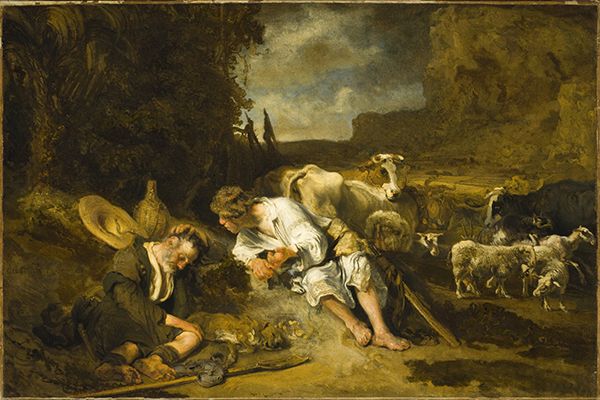
Mercury and Argus
This painting, which at first appears to be a pastoral genre scene, with two relaxing male figures and a group of cows and sheep, in fact presents a mythical story. In the story, the God Jupiter falls in love with a woman named Io, and he turns her into a cow to hide her from his jealous wife, Juno. When Juno learns of this deceit, she asks the shepherd Argus to guard the cow from Jupiter. Jupiter finds out, and sends Mercury to steal back the cow. Following Juno's orders, Argus gives Mercury wine until he falls asleep (the moment depicted by Fabritius), and proceeds to cut off his head with a sword (seen here laying to the left of Argus).
This painting marks Fabritius's evolution in style, away from Rembrandt, towards greater picture illumination. For centuries the painting was however catalogued as a Rembrandt (in 1764, believing it to be a genuine Rembrandt, the work was copied by Fragonard). Sotheby's changed the attribution to Fabritius as late as 1985 after discovering Fabritius's signature. His moniker, which appeared to have been obscured by paint at some point, was likely to have been concealed by someone hoping to sell the painting as a Rembrandt thereby increasing the work's value. Philip Conisbee, senior curator of European painting and sculpture at the Los Angeles County Museum of Art, notes that "The rich texturing is [indeed] like Rembrandt, but Fabritius used a subtle coloring and blond tonalities that should never [have been] mistaken for Rembrandt's work".
Oil on canvas - Los Angeles County Museum of Art
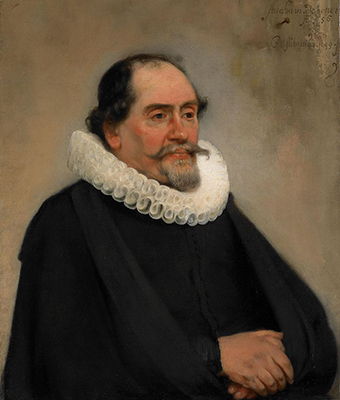
Portrait of Abraham de Potter
Fabritius was active as a portraitist from the late 1640s until his death. Portrait of Abraham de Potter was amongst his first. On first glance, his portrait of the silk merchant (Abraham de Potter) appears rather conventional. The sitter is dressed in sober black attire, and a stiff pleated ruff that was the height of fashion in mid-seventeenth century Holland. However, closer scrutiny of the painting reveals the artist's self-conscious departure from the stylistic preferences of his mentor.
While Rembrandt generally executed his portraits with bleak, opaque, backdrops and dramatically spot-lit subjects, Fabritius placed his sitter against a non-descript stained plaster wall, the goal being to bring heightened illumination to his subject who he captures with a deftness of delicately and touch. Indeed, Fabritius's most famous genre pieces, The Sentry and The Goldfinch, feature similarly weathered, light gray backgrounds. Fabritius's more animated approach would influence his Delft School colleagues Pieter de Hooch and Johannes Vermeer (the latter believed by some to have been a pupil of Fabritius's although this cannot be corroborated) both of whom employed blank backgrounds to the same effect.
However, a more remarkable feature of this painting is an astonishing trompe l'oeil which appears in the shape of a "protruding" nail, complete with shadow, that sits between the inscriptions of the sitter and painters' names. This feature attests to Fabritius's early interest in illusionist effects and his first professional attempts to use optical illusions to bring about a perception of three-dimensional realism. His was an interest shared by his friend (and fellow pupil under Rembrandt), Samuel van Hoogstraten. Both artists experimented with tromp l'oeil and intricate perspectives for paintings destined to be displayed in cylindrical perspective boxes. These served the duel function of shielding important paintings from dust damage and/or to surprise the viewer when the hinged portal or peephole was opened or exposed to reveal the three-dimensional picture housed within.
Oil on canvas - Rijksmuseum, Amsterdam
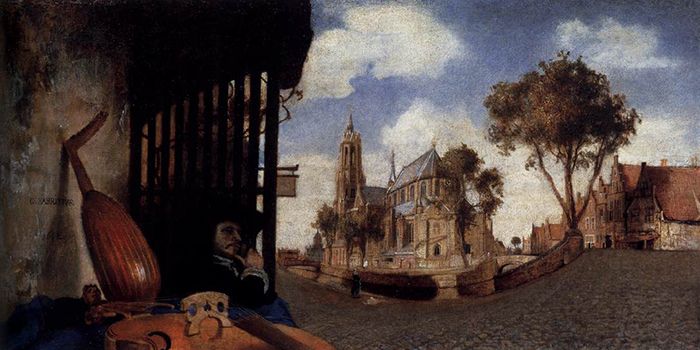
A View of Delft, with a Musical Instrument Seller's Stall
The View of Delft, a tiny panoramic picture measuring only 15.4 x 31.6 cm., is an anamorphic view of the town. In the foreground, a sullen looking street vendor guards a lute and a bass viol while to his left, in the background, we see the Nieuwe Kerk church, the Town Hall and a row of houses that stretch along the canal. The church is illumined against a blue and white sky while the glorious summer sky allows the trees to cast their shadows over buildings in a scene of many tonal reflections. Fabritius incorporated his signature into the scene, too, placing it on the wall behind the vendor, almost as if it were a piece of graffiti. The painting was completed two years after the son of Willem the Silent, Prince Willem II, had died and been laid to rest in the Nieuwe Kerk leading some to speculate that the painting was prompted in some way by the prince's death.
This scene was painted with an unusual and complex perspective, as if viewed through a wide-angle lens. The visual effect is enhanced by the dramatic foreshortening of the viol in the foreground. It is however believed that the painting was intended to be displayed on a curved surface, or viewed through a cylindrical perspective box, in which case the image would appear proportionate (when seen in three-dimensions). Although it cannot be ascertained exactly what type of viewing device the painting was created for, it is known that Fabritius experimented with, and even built, such devices (as did his friend Samuel van Hoogstraten, whose Peepshow with Views of the Interior of a Dutch House (1655-60) was executed just a few years after this work by Fabritius). Indeed, according to the writings of van Hoogstraten, Fabritius worked on several larger perspective paintings though these were most likely lost in the explosion that cut short his life.
Art historian and writer Walter Liedtke believes it likely that, while studying with Rembrandt in Amsterdam, Fabritius may have encountered intriguing ideas on perspective presented in a manuscript copy of the first edition of Leonardo's Trattato della Pittura (which was published in Paris for the first time in 1651). Liedtke argues that Fabritius's View of Delft "is one of the greatest and historically most significant monuments of seventeenth-century Dutch painting not because it broke with the tradition in any way, but precisely because it represents a conscious effort to extend the established representational conventions in accord with a deepening interest in the physical environment".
Oil on canvas - The National Gallery, London
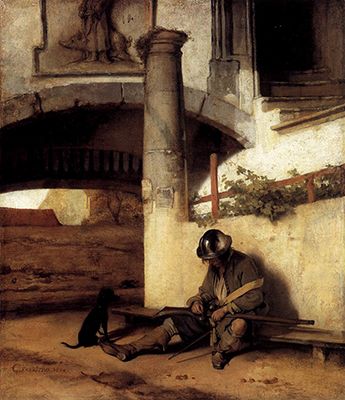
The Sentry
In this, undoubtedly the most enigmatic of all Fabritius's paintings, a sleeping sentry sits in front of three structures: a wall, a column and an arch. A small black dog watches the sentry as he naps while in the archway above, we see a relief of Anthony the Great, the patron saint of farmers and livestock (identifiable by the pig standing at his feet). This painting, completed the year of Fabritius's premature death, demonstrates the artist's preference for bright colors, clear light, atmospheric tone and his willingness to experiment with geometric architectural shapes in order to effect narrative anomalies.
Art historian Christopher Brown refers to The Sentry as "the most mystifying of all Fabritius's paintings", and with good reason. Indeed, one of the reasons The Sentry has resonated with historians down the centuries is the work's formal ambiguity and its lack of narrative closure; it is neither a coherent narrative nor a metaphorical painting. For instance, the street corner on which the sleepy sentry rests features a set of inconsistent architectural forms that effectively place the soldier in an unclassifiable location. The free-standing column appears to serve no other function than to obstruct the full opening of the gate while the general mood of ambiguity is only heightened through the stone relief inscribed with the half-figure of Anthony the Great. Its very presence suggests that it must be a narrational clue of some sort, but it only adds to the picture's hermeneutic puzzle.
A recent analysis revealed plans by the artist to include a second figure walking on the wall behind the gateway, although it remains unclear what narrative function this figure would have served. It has been posited that he (or she) may have been meant as an enemy, posing a threat to the unconscious sentry. Whatever the intention, the figure's inclusion would have only added to the painting's mystery. It is the fact that Fabritius was willing to push boundaries in this way that many historians have been willing to speculate that he would have usurped Rembrandt as the greatest master of the Dutch Golden Age.
Oil on canvas - Galerie Alte & Neue Meister - Staatliches Museum Schwerin, Schwerin, Germany
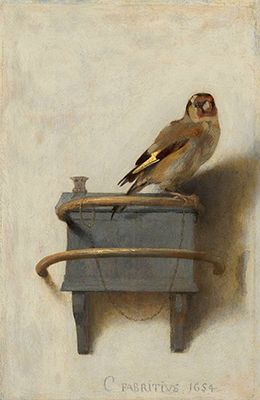
The Goldfinch
The Goldfinch holds a unique place in the history of Dutch painting. In this trompe-l'oeil painting, Fabritius depicts a European goldfinch (puttertje in Dutch), set against his signature whitewashed wall, and sat atop a bird feeder comprised of a blue container housed within two metal or wooden half-rings. Ostensibly, the painting belongs to a genre of still lifes that feature dead birds such as those produced by Fabritius's fellow countrymen Jan Baptist Weenix and Cornelis Lelienbergh. Fabritius's painting is not a still life, however. His bird is positively alive; able to fly away at any moment (were in not tethered to the lower ring).
The Goldfinch remains one of the most moving and powerful masterpieces of Dutch art because of the candour and simplicity of its composition. Unlike the aforementioned artists whose work was preoccupied with capturing picture minutiae, Fabritius eschewed fine detail in favor of a series of loose brush strokes to evoke the pet's feathered frame and the foreshortening of the animal's head (finer details are saved for the rings and chain). Fabritius was intent rather on creating an illusion of a bird ready for flight and if one viewed the image from a reasonable distance, then the soft shadows cast onto the blank wall by the bird, the feeding box and the lower ring (and the ring onto the box), give the painting a three-dimensionality.
Technical analysis of the painting, conducted in 2003, revealed that the panel on which the goldfinch is painted was once covered by a gilded frame, and attached with ten nails. Historians suspect that the work was at one point part of a piece of furniture (perhaps a door to a cabinet), or combined with another structure to serve as a cage for a painted, rather than living, bird. The analysis also revealed several small indentations in the surface of the work, leading to the hypothesis that the painting somehow (perhaps through divine intervention) survived the explosion that killed Fabritius and destroyed his studio.
Oil on panel - Mauritshuis Royal Picture Gallery, The Hague, Netherlands
Biography of Carel Fabritius
Childhood
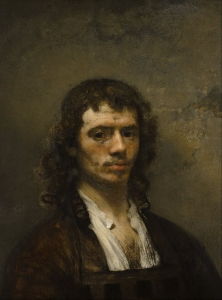
The eldest of three boys, Carel Pietersz was born to Pieter Carels and Berbertje van der Maes in Middenbeemster, Beemster polder, a small village north of Amsterdam. His father was a sexton, schoolteacher, and weekend painter, and, probably with the early guidance from their father, Carel and his brothers, Barent and Johannes, would all go on to become professional painters. However, it is known that Carel and Barent trained as carpenters and, according to the conventions of the time, adopted the surname "Fabritius" ("faber" being Latin for carpenter). In early 1641, Carel entered the Dutch Reformed Church and later that year married his neighbor, and sister of the local pastor, Aeltge Velthuys.
Education and Early Training
In 1641, Fabritius relocated to Amsterdam where he apprenticed under Rembrandt. He was joined by his brother, Barent, and the painter Samuel van Hoogstraten, with whom he would maintain a lifelong friendship. Indeed, art historians such as Piet Bakker have speculated that Hoogstraten might have later worked under Fabritius as a "full-fledged assistant". According to Ariane van Suchtelen, curator of the Mauritshuis museum, Fabritius learned a great deal from Rembrandt in a short time particularly "about light and the ability to capture emotions while using them to tell a story".
Fabritius's stay in Rembrandt's workshop ended after a little less than two years when Aeltge died in childbirth in the spring of 1643. It is doubtful that Fabritius's return to his parent's home (in Middenbeemster) was necessitated by monetary worries given that an inventory of Aeltge's assets show that she left behind the not insubstantial sum of 1,800 guilders (also listed amongst her possessions were two "ruw raengesmeerd" - roughly painted - pictures that are attributed to the hand of Fabritius). His earliest known painting, The Raising of Lazarus, is dated 1643 and, given what is known about the events around Aeltge's death, it is possible the painting could have been made either in Amsterdam or Middenbeemster.
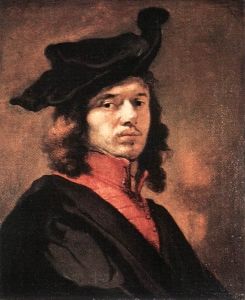
Details about Fabritius's life are scarce, but records do confirm that the painter was made godfather to his new-born sister, Cornelia, in 1646. He also painted Mercury and Argus and Mercury and Aglauros, works that confirm his divergence from the formal preferences of Rembrandt. Bakker writes that it is not known for sure if these works originated in Middenbeemster or Amsterdam but since it is "difficult to imagine that sparsely populated Middenbeemster afforded him sufficient clientele [..] it is therefore tempting to assume that he travelled back and forth to Amsterdam periodically in the years after his wife's death but before his departure for Delft in 1650".
It is known from the biographies of his small circle of patrons, however, that Fabritius painted a number of portraits before his relocation. In 1649, for instance, he painted the Middenbeemster silk merchant Abraham de Potter, and fellow trader, estate owner and art collector, Balthasar Deutz. It is also thought that he painted a self-portrait for the Amsterdam based silk-thrower Cornelis Smout and his wife Catharina Scharckens who owned an estate in Middenbeemster.
Mature Period
Having relocated to Delft in 1650, Fabritius set up his own studio, established a circle of donors, and even took on a pupil, Mattias Spoors. On August 14, he married the widow Agatha van Pruyssen. Married in Middenbeemster, the couple's residence was listed as Delft and it was in the municipality that Fabritius painted the majority of his "famous thirteen" paintings, including The Goldfinch and The Sentry. It was a further two years, however, before Fabritius joined the Delft painters' guild (the Guild of St. Luke). Other members included Johannes Vermeer, Nicolaes Maes, and Pieter de Hooch, and it is highly likely that Fabritius spent time with these artists.
Bakker attributed Fabritius's delay between arriving in Delft and joining the Guild to the fact that that there was a "profound crisis affecting the art market, which elsewhere in the Dutch Republic was felt strongly only as of the 1660s [but which] had already begun to impact Delft in the 1640s". Indeed, the fact that Fabritius accepted 12 guilders from the Delft town council to paint its coats of arms suggests that he was finding it difficult to make a living wage as a fine artist. Nevertheless, Fabritius still secured lucrative commissions including a number of large vistas of Delft such as those for the home of Theodorus Vallensis, dean of the Delft surgeons' guild and court physician to Stadholder Frederick Henry (His Highness the Prince of Orange). Bakker suggests in fact that one of the reasons that so few of his paintings have been preserved is because "every time new residents moved into a house there was a chance that - driven by taste or fashion - they would replace the wall painting with another kind of decoration".
Death
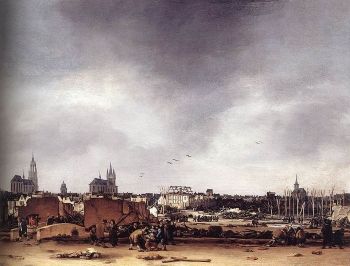
Fabritius died suddenly and tragically, in the explosion of the Delft gunpowder magazine on October 12, 1654. The blast destroyed a quarter of the city, including Fabritius' studio and several of his paintings. Fabritius' student Mattias Spoors, and local church deacon Simon Decker, who were with Fabritius in his studio working together on a religious painting at the time, were also killed. Bakker reports that Fabritius was buried within 48 hours of the explosion but his death threw up a new mystery. Agatha (his widow), when signing "an acknowledgment of debt", referred to her late husband "painter to His Highness, the Prince of Orange". Bakker argues that there was "not a shred of evidence for any commission executed for either Stadholder Frederick Henry or his son William II". However, that it would have been "inconceivable that Fabritius's widow would call him a 'court painter' without good reason" and that the blast would most likely have destroyed paintings newly commissioned by Amalia von Solms, the widow of Stadholder Frederick Hendrick.
The Legacy of Carel Fabritius
Fabritius was a leading member of the Delft School, and his influence, particularly in terms of experimentation with perspective and complex spatial effects, as well as the use of soft, atmospheric lighting and daylight effects, can be seen in the works of his esteemed Delft school colleagues, Johannes Vermeer and Pieter de Hooch.
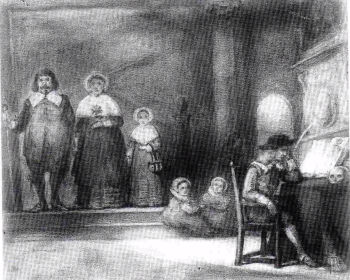
Given the tragic circumstances surrounding his death, Bakker has summed up Fabritius's legacy in terms of his potential - of what could, or should, have been. He wrote: "Famous paintings like The Goldfinch and The Sentry bespeak such originality and artistic quality that we can only regret all the works he never painted. Unfortunately, his untimely death has made it virtually impossible to determine whether his talent would have eventually been great enough to equal, if not surpass, that of his teacher, Rembrandt Van Rijn". Indeed, the promise shown in his small body of work has prompted other historians to predict that he might have supplanted Rembrandt as the grand master of the Dutch Golden Age.
What is beyond question however is his exploration on the "domestic interior" narrative that became a staple of the Delft School. His influence can be traced through the work of his contemporaries Vermeer (on whom his use of shadows and background light had a particularly marked effect), de Hooch and, indeed, other Dutch artists including Nicolaes Maes.
More recently, Fabritius's public profile gained fresh impetus following the release of Donna Tart's novel The Goldfinch, for which she received the 2014 Pulitzer Prize for Fiction. The Goldfinch, in which Fabritius's "priceless" painting survives a devasting gallery explosion, was turned into a Hollywood movie starring Ansel Elgort in 2019. The protagonist and secret custodian of the painting, Theo, says this of the artwork: "it is a glory and a privilege to love what Death doesn't touch. For if disaster and oblivion have followed this painting down through time - so too has love. Insofar as it is immortal (and it is) I have a small, bright, immutable part in that immortality".
Influences and Connections

-
![Johannes Vermeer]() Johannes Vermeer
Johannes Vermeer - Samuel van Hoogstraten
- Barent Fabritius
-
![Pieter de Hooch]() Pieter de Hooch
Pieter de Hooch -
![Jean-Honoré Fragonard]() Jean-Honoré Fragonard
Jean-Honoré Fragonard - Mattias Spoors
-
![Johannes Vermeer]() Johannes Vermeer
Johannes Vermeer - Samuel van Hoogstraten
- Barent Fabritius
 Ask The Art Story AI
Ask The Art Story AI